Alu 301 chapter 2 - Study guides, Class notes & Summaries
Looking for the best study guides, study notes and summaries about Alu 301 chapter 2? On this page you'll find 94 study documents about Alu 301 chapter 2.
Page 4 out of 94 results
Sort by
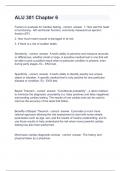
-
ALU 301 Chapter 6 Question and answers correctly solved 2024
- Exam (elaborations) • 9 pages • 2024
-
Available in package deal
-
- $14.49
- + learn more
ALU 301 Chapter 6 Question and answers correctly solved 2024 Factors to evaluate for Cardiac testing - correct answer 1. How well the heart is functioning - left ventricular function, commonly measured as ejection fraction (EF). 2. How much heart muscle is damaged or at risk. 3. If there is a risk of sudden death. Sensitivity - correct answer A test's ability to perceive and measure amounts or differences, whether small or large. A sensitive medical test is one that will be able to giv...
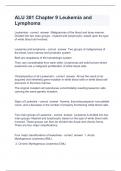
-
ALU 301 Chapter 9 Leukemia and Lymphoma Question and answers 2024 verified to pass
- Exam (elaborations) • 8 pages • 2024
-
Available in package deal
-
- $14.99
- + learn more
ALU 301 Chapter 9 Leukemia and Lymphoma Question and answers 2024 verified to passLeukemias - correct answer Malignancies of the blood and bone marrow. Divided into two main groups - myeloid and lymphocytic, based upon the type of white blood cell involved. Leukemia and lymphoma - correct answer Two groups of malignancies of the blood, bone marrow and lymphatic system Both are neoplasms of the hematologic system They vary considerable from each other. lymphomas are solid tumors where le...
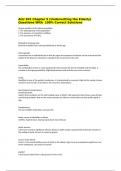
-
ALU 301 Chapter 5 (Underwriting the Elderly) Questions With 100% Correct Solutions
- Exam (elaborations) • 4 pages • 2024
-
Available in package deal
-
- $9.59
- + learn more
ALU 301 Chapter 5 (Underwriting the Elderly) Questions With 100% Correct Solutions Unique qualities of the elderly population 1. The heterogeneity of the population 2. The presence of comorbid conditions 3. The occurrence of Frailty. Population heterogeneity Diversity in health status among individuals of similar age. Heterogeneity Is expressed on an individual basis in that the signs and symptoms of disease can be unusual and the impact of the disease on function is variable fr...
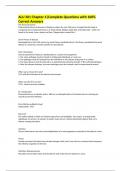
-
ALU 301 Chapter 4|Complete Questions with 100% Correct Answers
- Exam (elaborations) • 9 pages • 2024
-
Available in package deal
-
- $10.39
- + learn more
ALU 301 Chapter 4|Complete Questions with 100% Correct Answers The Humoral System Predominant theory of disesase in Western culture for over 200 years. It taught that the body is composed of four balanced humors, or fluids: blood, phlegm, black bile, and yellow bile - which are found in the heart, brain, spleen and liver. (Hippocrates created this.) Germ Theory of Disease Developed late in the 19th century by Louis Pateur and Robert Koch. This theory postulated that each disease is cause...
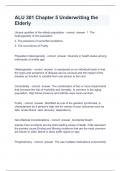
-
ALU 301 Chapter 5 Underwriting the Elderly Question and answers 100% correct 2024
- Exam (elaborations) • 7 pages • 2024
-
Available in package deal
-
- $14.49
- + learn more
ALU 301 Chapter 5 Underwriting the Elderly Question and answers 100% correct 2024 Unique qualities of the elderly population - correct answer 1. The heterogeneity of the population 2. The presence of comorbid conditions 3. The occurrence of Frailty. Population heterogeneity - correct answer Diversity in health status among individuals of similar age. Heterogeneity - correct answer Is expressed on an individual basis in that the signs and symptoms of disease can be unusual and the...
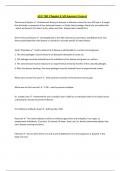
-
ALU 301 Chapter 4 All Answers Correct
- Exam (elaborations) • 10 pages • 2024
-
Available in package deal
-
- $9.49
- + learn more
ALU 301 Chapter 4 All Answers Correct The Humoral System ️Predominant theory of disesase in Western culture for over 200 years. It taught that the body is composed of four balanced humors, or fluids: blood, phlegm, black bile, and yellow bile - which are found in the heart, brain, spleen and liver. (Hippocrates created this.) Germ Theory of Disease ️Developed late in the 19th century by Louis Pateur and Robert Koch. This theory postulated that each disease is caused by a microbe spec...
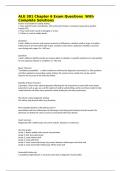
-
ALU 301 Chapter 6 Exam Questions With Complete Solutions Graded A+
- Exam (elaborations) • 6 pages • 2024
- Available in package deal
-
- $9.69
- + learn more
ALU 301 Chapter 6 Exam Questions With Complete Solutions Factors to evaluate for Cardiac testing 1. How well the heart is functioning - left ventricular function, commonly measured as ejection fraction (EF). 2. How much heart muscle is damaged or at risk. 3. If there is a risk of sudden death. Sensitivity A test's ability to perceive and measure amounts or differences, whether small or large. A sensitive medical test is one that will be able to give a positive result when a particula...
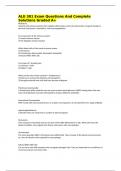
-
ALU 301 Exam Questions And Complete Solutions Exam Bundle | 100% Verified (Package Deal)
- Package deal • 12 items • 2024
-
- $26.49
- + learn more
Exam (elaborations) ALU 301 Exam Questions And Complete Solutions Graded A+ALU 301 Chapter 5 (Underwriting the Elderly) Questions With 100% Correct SolutionsALU 301 - Ch 2 - Inflammatory Bowel Disease (2024)ALU 301: Chapter 3: (Rheumatoid Arthritis) Test With Complete Solutions
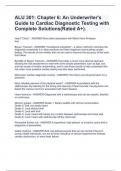
-
ALU 301: Chapter 6: An Underwriter's Guide to Cardiac Diagnostic Testing with Complete Solutions(Rated A+).
- Exam (elaborations) • 6 pages • 2024
-
Available in package deal
-
- $10.99
- + learn more
ALU 301: Chapter 6: An Underwriter's Guide to Cardiac Diagnostic Testing with Complete Solutions(Rated A+). Heart "Clicks" - ANSWER-Most often associated with Mitral Valve Prolapse test. Bayes' Theorem - ANSWER-"Conditional probability" - a ration method to minimize the diagnostic uncertainty (i.e. false positives and false negatives) surrounding cardiac testing. The results of one cardiac test can be used to improve the accuracy of the tests that follow. Benefits of Bayes' Theore...
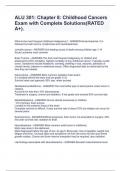
-
ALU 301: Chapter 8: Childhood Cancers Exam with Complete Solutions(RATED A+).
- Exam (elaborations) • 3 pages • 2024
-
Available in package deal
-
- $9.49
- + learn more
ALU 301: Chapter 8: Childhood Cancers Exam with Complete Solutions(RATED A+).What is the most frequent childhood malignancy? - ANSWER-Acute leukemia. It is followed by brain tumors, lymphomas and neuroblastomas. Juvenile cancer - ANSWER-2nd leading cause of death among children age 1-14 Acute Leukemia most common Brain Tumors - ANSWER-The 2nd most frequent malignancy in children and adolescents (45% mortality). highest morbidity of any childhood cancer. Typically a solid tumor. Symptoms i...

$6.50 for your textbook summary multiplied by 100 fellow students... Do the math: that's a lot of money! Don't be a thief of your own wallet and start uploading yours now. Discover all about earning on Stuvia


